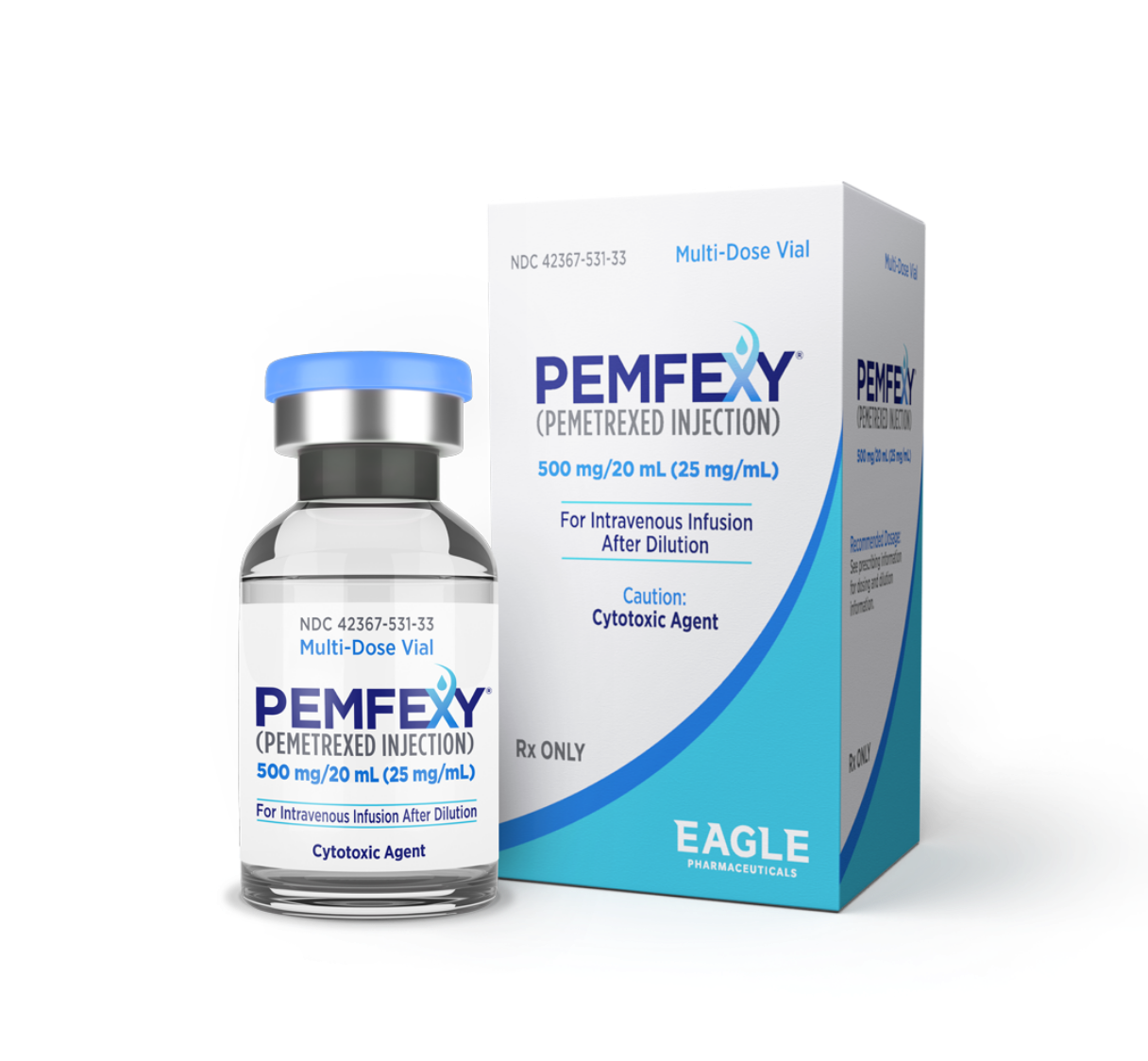

Indicated for use in Combination with
Pembrolizumab and Platinum Chemotherapy*
*for the initial treatment of patients with metastatic non-squamous non-small cell lung cancer (NSCLC), with no EGFR or ALK genomic tumor aberrations
Supplied as a Solution in a Multi-dose Vial
- No reconstitution required
- Ready-to-dilute
-
—Two diluent options: 5% Dextrose in Water, USP or Normal Saline
-
- Partially used vials containing undiluted product can be stored in refrigeration for up to 28 days
-
—Store refrigerated at 2°C to 8°C (36°F to 46°F)
-
- Diluted product has a 48-hour beyond-use date
-
—Store refrigerated at 2°C to 8°C (36°F to 46°F)
-
—PEMFEXY® diluted with 5% Dextrose in Water, USP can also be stored at ambient room temperature and lighting
-
UNIQUE J-CODE J9304 |
NDC 42367-531-33
PEMFEXY® is Supported by the EAGLE CAN® Program
Providing you and your patients comprehensive reimbursement and access solutions
PEMFEXY® is supported by the EAGLE CAN® program
Providing you and your patients comprehensive reimbursement and access solutions
PEMFEXY® is supported by the EAGLE CAN® program
Providing you and your patients comprehensive reimbursement and access solutions

Downloadable Resources for Healthcare Providers
Contact an Eagle Representative Today to Learn More about PEMFEXY®
Call Eagle Customer Service at 855-318-2170 from 9:00 AM – 5:00 PM ET
Downloadable Resources for Healthcare Providers
Contact an Eagle Representative today to learn more about PEMFEXY®
Call Eagle Customer Service at 855-318-2170 from 9 AM – 5 PM ET
Add Your Heading Text Here
Contact an Eagle Representative today to learn more about PEMFEXY®
Call Eagle Customer Service at 855-318-2170 from 9 AM – 5 PM ET
INDICATION
PEMFEXY is indicated in combination with pembrolizumab and platinum chemotherapy, for the initial treatment of patients with metastatic non-squamous non-small cell lung cancer (NSCLC), with no EGFR or ALK genomic tumor aberrations.PEMFEXY is indicated in combination with cisplatin for the initial treatment of patients with locally advanced or metastatic non-squamous non-small cell lung cancer (NSCLC).
PEMFEXY is indicated as a single agent for the maintenance treatment of patients with locally advanced or metastatic non-squamous non-small cell lung cancer (NSCLC) whose disease has not progressed after four cycles of platinum-based first-line chemotherapy.
PEMFEXY is indicated as a single agent for the treatment of patients with recurrent, metastatic non-squamous non-small cell lung cancer (NSCLC) after prior chemotherapy.
Limitation of Use: PEMFEXY is not indicated for the treatment of patients with squamous cell non-small cell lung cancer.
PEMFEXY is indicated in combination with cisplatin for the initial treatment of patients with malignant pleural mesothelioma (MPM), whose disease is unresectable or who are otherwise not candidates for curative surgery.
IMPORTANT SAFETY INFORMATION
CONTRAINDICATIONPEMFEXY is contraindicated in patients who have a history of severe hypersensitivity reaction to pemetrexed.
WARNINGS AND PRECAUTIONS
Myelosuppression and Increased Risk of Myelosuppression Without Vitamin Supplementation
PEMFEXY can cause severe myelosuppression resulting in a requirement for transfusions and which may lead to neutropenic infection. The risk of myelosuppression is increased in patients who do not receive vitamin supplementation.
7 Days prior to treatment with PEMFEXY, patients must be instructed to initiate supplementation with oral folic acid. Intramuscular injections of vitamin B12 are also required 7 days prior to PEMFEXY treatment. Continue vitamin supplementation during treatment and for 21 days after the last dose of PEMFEXY to reduce the severity of treatment-related hematologic and gastrointestinal toxicities. Obtain a complete blood count at the beginning of each cycle. Do not administer PEMFEXY until the ANC is at least 1500 cells/mm3 and platelet count is at least 100,000 cells/mm3. Permanently reduce PEMFEXY in patients with an ANC of less than 500 cells/mm3 or platelet count of less than 50,000 cells/mm3 in previous cycles
In Studies JMDB and JMCH, among patients who received vitamin supplementation, incidence of Grade 3-4 neutropenia was 15% and 23%, the incidence of Grade 3-4 anemia was 6% and 4%, and incidence of Grade 3-4 thrombocytopenia was 4% and 5%, respectively. In Study JMCH, 18% of patients in the pemetrexed arm required red blood cell transfusions compared to 7% of patients in the cisplatin arm. In Studies JMEN, para-dMOUNT, and JMEI, where all patients received vitamin supplementation, incidence of Grade 3-4 neutropenia ranged from 3% to 5%, and incidence of Grade 3-4 anemia ranged from 3% to 5%.
Renal Failure
Pemetrexed can cause severe, and sometimes fatal, renal toxicity. Determine creatinine clearance before each dose and periodically monitor renal function during treatment with PEMFEXY. The incidences of renal failure in clinical studies in which patients received pemetrexed with cisplatin were 2.1% in Study JMDB and 2.2% in Study JMCH. The incidence of renal failure in clinical studies in which patients received pemetrexed as a single agent ranged from 0.4% to 0.6% (Studies JMEN, para-dMOUNT, and JMEI). Withhold PEMFEXY in patients with a creatinine clearance of less than 45 mL/min.
Bullous and Exfoliative Skin Toxicity
Serious and sometimes fatal, bullous, blistering, and exfoliative skin toxicity, including cases suggestive of Stevens-Johnson Syndrome/toxic epidermal necrolysis, can occur with pemetrexed. Permanently discontinue PEMFEXY for severe and life-threatening bullous, blistering, or exfoliating skin toxicity.
Interstitial Pneumonitis
Serious interstitial pneumonitis, including fatal cases, can occur with pemetrexed. Withhold PEMFEXY for acute onset of new or progressive unexplained pulmonary symptoms such as dyspnea, cough, or fever pending diagnostic evaluation. If pneumonitis is confirmed, permanently discontinue PEMFEXY.
Radiation Recall
Radiation recall can occur with pemetrexed in patients who have received radiation weeks to years previously. Monitor patients for inflammation or blistering in areas of previous radiation treatment. Permanently discontinue PEMFEXY for signs of radiation recall.
Increased Risk of Toxicity with Ibuprofen in Patients with Renal Impairment
Exposure to pemetrexed is increased in patients with mild to moderate renal impairment who take concomitant ibuprofen, increasing the risks of adverse reactions of pemetrexed. In patients with creatinine clearances between 45 mL/min and 79 mL/min, avoid administration of ibuprofen for 2 days before, the day of, and 2 days following administration of PEMFEXY. If concomitant ibuprofen use cannot be avoided, monitor patients more frequently for pemetrexed adverse reactions, including myelosuppression, renal, and gastrointestinal toxicity.
Embryo-Fetal Toxicity
Based on findings from animal studies and its mechanism of action, PEMFEXY can cause fetal harm when administered to a pregnant woman. In animal reproduction studies, intravenous administration of pemetrexed to pregnant mice during the period of organogenesis was teratogenic, resulting in developmental delays and increased malformations at doses lower than the recommended human dose of 500 mg/m2. Advise pregnant women of the potential risk to the fetus. Advise females of reproductive potential to use effective contraception during treatment with PEMFEXY and for 6 months after the final dose. Advise males with female partners of reproductive potential to use effective contraception during treatment with PEMFEXY and for 3 months after the final dose.
DRUG INTERACTIONS
Ibuprofen increases exposure (AUC) of pemetrexed. In patients with creatinine clearance between 45 mL/min and 79 mL/min:
- Avoid administration of ibuprofen for 2 days before, the day of, and 2 days following administration of PEMFEXY.
- Monitor patients more frequently for myelosuppression, renal, and gastrointestinal toxicity, if concomitant administration of ibuprofen cannot be avoided.
Severe adverse reactions (Grade 3-4) occurring in ≥20% of patients with metastatic non-squamous non-small cell lung cancer (NSCLC) receiving pemetrexed in combination with pembrolizumab and platinum chemotherapy (carboplatin or cisplatin) versus pemetrexed with platinum chemotherapy + placebo for initial treatment (KEYNOTE-189), respectively, were fatigue (12% vs 6%); diarrhea (5% vs 3%); dyspnea (3.7% vs 5%); vomiting (3.7% vs 3%); nausea (3.5% vs 3.5%); rash (2% vs 2.5%); decreased appetite (1.5% vs 0.5%); constipation (1% vs 0.5%); and pyrexia (0.2% vs 0%).
Common adverse reactions (all grades) occurring in ≥20% of patients with metastatic non-squamous non-small cell lung cancer (NSCLC) receiving pemetrexed in combination with pembrolizumab and platinum chemotherapy (carboplatin or cisplatin) versus pemetrexed with platinum chemotherapy + placebo for initial treatment (KEYNOTE-189), respectively, were nausea (56% vs 52%); fatigue (56% vs 58%); constipation (35% vs 32%); diarrhea (31% vs 21%); decreased appetite (28% vs 30%); rash (25% vs 17%); vomiting (24% vs 23%); cough (21% vs 28%); dyspnea (21% vs 26%); and pyrexia (20% vs 15%).
Severe adverse reactions (Grade 3-4) occurring in fully vitamin supplemented patients with locally advanced or metastatic non-squamous non-small cell lung cancer (NSCLC) receiving pemetrexed in combination with cisplatin versus gemcitabine in combination with cisplatin for initial treatment (JMDB), respectively, were neutropenia (15% vs 27%); fatigue (7% vs 5%); nausea (7% vs 4%); anemia (6% vs 10%); vomiting (6% vs 6%); thrombocytopenia (4% vs 13%); anorexia (2% vs 1%); diarrhea (1% vs 2%); elevated creatinine (1% vs 1%); stomatitis/pharyngitis (1% vs 0%); and constipation (1% vs 0%).
Common adverse reactions (all grades) occurring in ≥5% fully vitamin supplemented patients with locally advanced or metastatic non-squamous non-small cell lung cancer (NSCLC) receiving pemetrexed in combination with cisplatin versus gemcitabine in combination with cisplatin for initial treatment (JMDB), respectively, were nausea (56% vs 53%); fatigue (43% vs 45%); vomiting (40% vs 36%); anemia (33% vs 46%); neutropenia (29% vs 38%); anorexia (27% vs 24%); constipation (21% vs 20%); stomatitis/pharyngitis (14% vs 12%); alopecia (12% vs 21%); diarrhea (12% vs 13%); thrombocytopenia (10% vs 27%); elevated creatinine (10% vs 7%), sensory neuropathy (9% vs 12%); taste disturbance (8% vs 9%); rash/desquamation (7% vs 8%); and dyspepsia/heartburn (5% vs 6%).
Severe adverse reactions (Grade 3-4) occurring in patients with non-progressive locally advanced or metastatic non-squamous non-small cell lung cancer (NSCLC) receiving pemetrexed as a single agent versus placebo as maintenance treatment (JMEN), respectively, following non-pemetrexed containing, platinum-based induction therapy were fatigue (5% vs 1%); anemia (3% vs 1%); neutropenia (3% vs 0%); infection (2% vs 0%); anorexia (2% vs 0%); nausea (1% vs 1%); mucositis/stomatitis (1% vs 0%); diarrhea (1% vs 0%); and sensory neuropathy (1% vs 0%). Common adverse reactions (all grades) occurring in ≥5% patients with non-progressive locally advanced or metastatic non-squamous non-small cell lung cancer (NSCLC) receiving pemetrexed as a single agent versus placebo as maintenance treatment (JMEN), respectively, following non-pemetrexed containing, platinum-based induction therapy were fatigue (25% vs 11%); nausea (19% vs 6%); anorexia (19% vs 5%); anemia (15% vs 6%); increased ALT (10% vs 4%); rash/desquamation (10% vs 3%); sensory neuropathy (9% vs 4%); vomiting (9% vs 1%); increased AST (8% vs 4%); mucositis/stomatitis (7% vs 2%); neutropenia (6% vs 0%); diarrhea (5% vs 3%); and infection (5% vs 2%).
Severe adverse reactions (Grade 3-4) occurring in patients with non-progressive locally advanced or metastatic non-squamous non-small cell lung cancer (NSCLC) receiving pemetrexed as a single agent versus placebo as maintenance treatment (para-dMOUNT), respectively, following pemetrexed plus cisplatin induction therapy were anemia (4.8% vs 0.6%); fatigue (4.5% vs 0.6%); neutropenia (3.9% vs 0%); nausea (0.3% vs 0%); and mucositis/stomatitis (0.3% vs 0%).
Common adverse reactions (all grades) occurring in ≥5% patients with non-progressive locally advanced or metastatic non-squamous non-small cell lung cancer (NSCLC) receiving pemetrexed as a single agent versus placebo as maintenance treatment (para-dMOUNT), respectively, following pemetrexed plus cisplatin induction therapy were fatigue (18% vs 11%); anemia (15% vs 4.8%); nausea (12% vs 2.4%); neutropenia (9% vs 0.6%); vomiting (6% vs 1.8%); edema (5% vs 3.6%); and mucositis/stomatitis (5% vs 2.4%).
Severe adverse reactions (Grade 3-4) occurring in fully supplemented patients with recurrent metastatic non-squamous non-small cell lung cancer (NSCLC) receiving pemetrexed as a single agent versus docetaxel as 2nd-line treatment after prior chemotherapy (JMEI), respectively, were neutropenia (5% vs 40%); fatigue (5% vs 5%); anemia (4% vs 4%); nausea (3% vs 2%); anorexia (2% vs 3%); vomiting (2% vs 1%); thrombocytopenia (2% vs 0%); increased ALT (2% vs 0%); alopecia (1% vs 2%); stomatitis/pharyngitis (1% vs 1%); and increased AST (1% vs 0%). Common adverse reactions (all grades) occurring in ≥5% of fully supplemented patients with recurrent metastatic non-squamous non-small cell lung cancer (NSCLC) receiving pemetrexed as a single agent versus docetaxel as 2nd-line treatment after prior chemotherapy (JMEI), respectively, were fatigue (34% vs 36%); nausea (31% vs 17%); anorexia (22% vs 24%); anemia (19% vs 22%); vomiting (16% vs 12%); stomatitis/pharyngitis (15% vs 17%); rash/desquamation (14% vs 6%); diarrhea (13% vs 24%); neutropenia (11% vs 45%); fever (8% vs 8%); thrombocytopenia (8% vs 1%); increased ALT (8% vs 1%); pruritus (7% vs 2%); increased AST (7% vs 1%); alopecia (6% vs 38%); and constipation (6% vs 4%).
Severe adverse reactions (Grade 3-4) occurring in fully supplemented subgroup of patients with malignant pleural mesothelioma (MPM) receiving pemetrexed in combination with cisplatin versus cisplatin alone (JMCH), respectively, were neutropenia (23% vs 3%); nausea (12% vs 6%); vomiting (11% vs 4%); fatigue (10% vs 9%); thrombocytopenia (5% vs 0%); dehydration (4% vs 1%); anemia (4% vs 0%); diarrhea (4% vs 0%); stomatitis/pharyngitis (3% vs 0%); decreased creatinine clearance (1% vs 2%); elevated creatinine (1% vs 1%); anorexia (1% vs 1%); constipation (1% vs 1%); dyspepsia (1% vs 0%); and rash (1% vs 0%).
Common adverse reactions (all grades) occurring in ≥5% of fully supplemented subgroup of patients with malignant pleural mesothelioma (MPM) receiving pemetrexed in combination with cisplatin versus cisplatin alone (JMCH), respectively, were nausea (82% vs 77%); vomiting (57% vs 50%); neutropenia (56% vs 13%); fatigue (48% vs 42%); anemia (26% vs 10%); thrombocytopenia (23% vs 9%); stomatitis/pharyngitis (23% vs 6%); anorexia (20% vs 14%); diarrhea (17% vs 8%); decreased creatinine clearance (16% vs 18%); rash (16% vs 5%); constipation (12% vs 7%); elevated creatinine (11% vs 10%); alopecia (11% vs 6%); sensory neuropathy (10% vs 10%); taste disturbance (8% vs 6%); dehydration (7% vs 1%); conjunctivitis (5% vs 1%); and dyspepsia (5% vs 1%).
USE IN SPECIFIC PATIENT POPULATIONS
Pregnancy
There are no available data on pemetrexed use in pregnant women. Based on findings from animal studies and its mechanism of action, PEMFEXY can cause fetal harm when administered to a pregnant woman. In animal reproduction studies, intravenous administration of pemetrexed to pregnant mice during the period of organogenesis was teratogenic, resulting in developmental delays and malformations at doses lower than the recommended human dose of 500 mg/m2. Advise pregnant women on the potential risk to a fetus.
Lactation
There is no information regarding the presence of pemetrexed or its metabolites in human milk, the effects on the breastfed infant, or the effects on milk production. Because of the potential for serious adverse reactions in breastfed infants from PEMFEXY, advise women not to breastfeed during treatment with PEMFEXY and for one week after last dose.
Females and Males of Reproductive Potential
Verify pregnancy status of females of reproductive potential prior to initiating PEMFEXY. PEMFEXY can cause fetal harm when administered to a pregnant woman. Because of the potential for genotoxicity, advise females of reproductive potential to use effective contraception during treatment with PEMFEXY and for 6 months after the final dose. Because of the potential for genotoxicity, advise males with female partners of reproductive potential to use effective contraception during treatment with PEMFEXY and for 3 months after the final dose. PEMFEXY may impair fertility in males of reproductive potential. It is not known whether these effects on fertility are reversible.
Pediatric Use
The safety and effectiveness of PEMFEXY in pediatric patients have not been established. Adverse reactions observed in pediatric patients studied were similar to those observed in adults.
Geriatric Use
The incidences of Grade 3-4 anemia, fatigue, thrombocytopenia, hypertension, and neutropenia were higher in patients 65 years of age and older as compared to younger patients in at least one of five randomized clinical trials. Renal Impairment PEMFEXY is primarily excreted by the kidneys. Decreased renal function results in reduced clearance and greater exposure (AUC) to pemetrexed compared with patients with normal renal function. No dosage is recommended for patients with creatinine clearance less than 45 mL/min.
For safety and dosing guidelines for PEMFEXY, see complete Warnings and Precautions, Adverse Reactions, and Dosage and Administration sections in the full Prescribing Information.
To report SUSPECTED ADVERSE REACTIONS, contact Eagle Pharmaceuticals, Inc. at 1-855-318-2170 or FDA at 1-800-FDA-1088 or www.fda.gov/medwatch.



